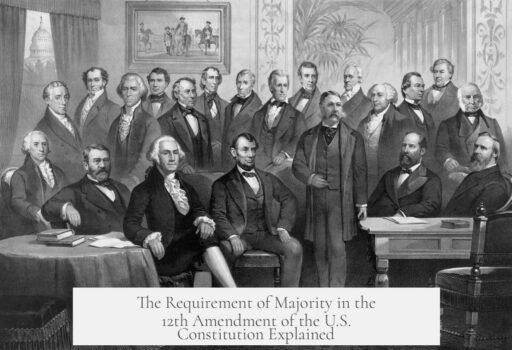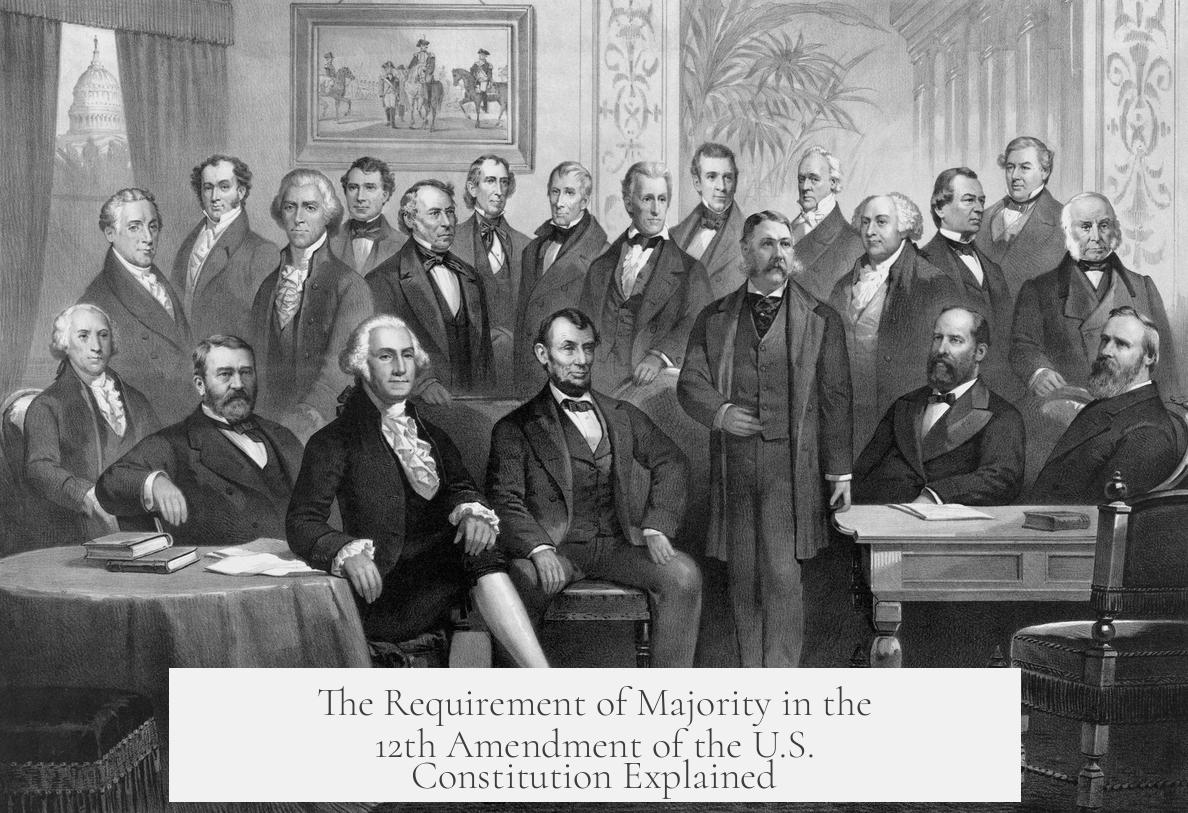The 12th Amendment of the U.S. Constitution requires a majority and not a plurality in presidential elections due to historical failures of the original electoral system, concerns over political legitimacy, and the need to avoid electoral deadlocks like the crisis in the 1800 election. This majority requirement ensures clear mandates and political stability in selecting the President and Vice President.
Originally, under Article II, Section 1, Clause 3, each elector cast two undifferentiated votes for President. Electors did not specify a preference between President and Vice President. If no candidate received a majority of electoral votes, the election was decided by the House of Representatives. The House voted by state delegations, with each state having one vote, choosing from the top five candidates. This system aimed to limit political parties’ influence and encourage electors to pick the “best men.”
However, this system proved unworkable. The election of 1800 exposed its flaws dramatically. Thomas Jefferson and Aaron Burr, both Democratic-Republicans, received an equal number of electoral votes due to how electors voted. This tie forced the House to decide the outcome. In the House, the 16 states were split evenly between Federalist and Democratic-Republican majorities. The resulting deadlock took 36 ballots to break, with Alexander Hamilton persuading some Federalists to back Jefferson. This fiasco showed that the ambiguous voting and plurality rule could cause unresolved elections and political crises.
The founders had varied opinions on whether a majority was essential. Some, like George Mason, expected that elections would frequently require the House to choose the President, suggesting a majority threshold was unrealistic in practice. Others such as Madison and Hamilton considered allowing a simple plurality to win, thereby avoiding the legislature’s involvement altogether. Despite this, the political realities of balance and compromise meant that the majority standard prevailed.
Politically, removing the majority requirement was unattractive. The Electoral College system itself was a compromise to prevent Congress from selecting the President directly, and concerns over direct national popular votes remained strong. Replacing the original system entirely or lowering the winner threshold to a plurality was unlikely to gain bipartisan support. The parties feared losing influence or encouraging electoral chaos.
The 12th Amendment, ratified in 1804, enacted targeted reforms without abandoning the fundamentals. It required electors to cast separate votes for President and Vice President, preventing ties such as in 1800. It also narrowed the House’s choice to the top three candidates instead of five. For the Vice President, the Senate gained the power to break deadlocks by choosing among the top two candidates. These changes reduced the chance of legislative stalemates but preserved the majority vote requirement for electoral victory.
| Aspect | Before 12th Amendment | After 12th Amendment |
|---|---|---|
| Elector Voting Method | Two votes undifferentiated | Separate votes for President and Vice President |
| Threshold to Win | Majority electoral votes required | Majority electoral votes required |
| House Role | Chooses President from top 5 | Chooses President from top 3 |
| Senate Role | None for Vice President | Chooses Vice President from top 2 if no majority |
The majority requirement remains because it best reflects the need for a clear, legitimate mandate, minimizing disputes over who won. A plurality could lead to presidents elected with only a small fraction of total electoral support, increasing the risk of political instability. The deadlock of 1800 demonstrated how a lack of a clear majority could paralyze government operations. The amendment’s adjustments sought to preserve stability while addressing the immediate flaws.
Broader reforms were impractical. Amendments require a two-thirds majority in both houses of Congress, challenging any proposals that could favor one party or region disproportionately. Political caution favored incremental changes rather than overhauling the Electoral College, since the existing system balanced diverse interests across states and parties. The 12th Amendment was a practical solution, reinforcing a majority vote as a safeguard against ambiguity.
The bipartisan consensus embraced these modest fixes to avoid a repeat of the 1800 chaos. Although founders debated the majority rule’s merits, they recognized that plurality elections without legislative backups risked divisive outcomes. As a result, retaining the majority rule and imposing separate votes for President and Vice President supported both political stability and electoral clarity.
- The original electoral system failed to produce clear outcomes, notably in 1800.
- The majority vote ensures a president has definitive electoral support.
- The 12th Amendment introduced separate votes for President and Vice President and narrowed the House’s options.
- Political compromises prevented replacing the majority threshold with a plurality.
- Maintaining the majority rule prevents electoral deadlocks and ensures government functionality.
Why does the 12th Amendment of the U.S. Constitution require a majority and not a plurality?
The 12th Amendment requires a majority because history taught the Founders a tough lesson: plurality leads to chaos, confusion, and political gridlock. The failure of the original electoral system, exposed vividly in the 1800 election, showed why a clear majority was essential to ensure stability and legitimacy in choosing the President and Vice President. Let’s dive into why the framers of the Constitution insisted on this majority threshold and how the 12th Amendment addressed the issues.
The original electoral process, laid out in Article II, Section 1, Clause 3, was… well, let’s say ambitious. Electors cast two votes each, without distinguishing which was for President or Vice President. This system hoped to discourage political parties from influencing elections and instead encourage picking the “best men.” Sounds noble, right? But reality had other plans.
In practice, this approach was, to put it gently, delusional. Political parties grew, and the idea that electors would independently choose the wisest candidates unraveled spectacularly. The 1800 presidential election perfectly illustrated this flaw.
That year, Thomas Jefferson and Aaron Burr, both from the Democratic-Republican Party, ended up tied because electors couldn’t—or didn’t—differentiate their votes properly. The result? The election was thrown to the House of Representatives, which faced a deadlock for 36 ballots. It took the intervention of Alexander Hamilton, who convinced some Federalists to break ranks and support Jefferson, to finally end the stalemate.
This mess exposed an uncomfortable truth: plurality, or merely having the most votes without crossing the 50% mark, wasn’t enough to produce a decisive and accepted leader. When votes are evenly split, as in 1800, relying on a House vote based on state delegations—where even half the states supporting one side wasn’t enough—creates paralysis.
Some Founding Fathers like George Mason expected elections to go to the House “nineteen times out of twenty,” assuming political deadlocks were common and inevitable. Others, like James Madison and Alexander Hamilton, actually preferred allowing a president to win by a simple plurality to avoid these ties. Yet political realities, including fear of giving Congress too much power in selecting the President, pushed against abandoning majority requirements.
Enter the 12th Amendment, ratified in 1804. It wasn’t a total reboot but a series of targeted fixes that recognized the messy 1800 debacle. Electors now vote separately for President and Vice President. This seemingly small change prevents scenarios like Jefferson-Burr’s tie, where candidates from the same party end up competing against each other.
The amendment also narrows the House’s choice to the top three candidates if no majority is reached in the Electoral College, instead of the top five. This reduces the chances of an unruly, sprawling contest. The Vice President’s backup election is assigned to the Senate, which picks between the top two candidates there, serving as a safety valve if the House deadlocks again. Since the VP breaks ties in the Senate, this setup cleverly avoids complete stalemates.
Despite those fixes, the 12th Amendment kept the fundamental majority requirement intact. Why? Because political compromise and caution had a big say here. Nobody wanted to scrap the Electoral College entirely or reduce the threshold to a simple plurality, which many feared could lead to more chaos or illegitimate wins.
For one, the Electoral College was—and remains—a compromise balancing population and state sovereignty interests. Changing the majority rule would shift power dynamics, possibly favoring larger states or political coalitions. Additionally, passing constitutional amendments is no picnic; it demands two-thirds support in both congressional houses.
The political momentum to overhaul the system was weak. Most leaders agreed that incremental fixes to avoid deadlocks were enough for the time being. The bipartisan desire to never repeat the 1800 election’s problems was strong, but so was a reluctance to trigger new, unforeseen issues by drastically lowering election standards.
So why choose a majority instead of a plurality? Because a majority vote ensures the President commands more than half the electors’ support, lending stronger legitimacy and a clearer mandate. Plurality can mean winning with less than half, which risks shaky political authority and potential challenges. The 12th Amendment’s majority rule roots the presidency in clear democratic support while managing political realities cleverly.
Imagine if the 1800 election had gone to a simple plurality rule. We might have had Presidents taking office with only a third or less of the vote, sowing doubt and factional tensions every four years. The majority requirement raises the bar for legitimacy, making sure winners have substantial backing.
In practice, this means the 12th Amendment carefully balances:
- Clear decisiveness: Avoid ambiguous or deadlocked elections.
- Legitimacy: Ensure Presidents command broad support.
- Political stability: Prevent partisan gridlock in Congress over presidential selection.
Has this fixed all election issues? Not exactly, but it significantly reduced risks and clarified the process. The 12th Amendment remains a smart compromise born from hard-earned lessons rather than perfect foresight.
To take a practical tip from this history: When designing any decision system—whether an election, board vote, or committee choice—requiring a majority helps avoid deadlocks and builds stronger consensus. Pluralities might be easier, but they often come with chaos in tow.
In summary, the 12th Amendment demands a majority because the Founders needed a stable, clear-cut way to select leaders after firsthand experience with failure. It was less about perfection and more about avoiding disastrous splits like 1800. The majority rule is a political safety net, a guardrail preventing fragile pluralities from paralyzing the government.
“No one wanted a repeat of the 1800 election,” where political impasses nearly froze the country. The 12th Amendment meets this demand through majority thresholds, smart structural fixes, and deep respect for balance and stability.
So next time you wonder why the U.S. President must win an outright majority of Electoral College votes, remember: it’s not stubborn tradition. It’s a carefully preserved fix born from a chaotic crisis, designed to keep democracy robust and functioning. How’s that for some constitutional wisdom mixed with political reality?




